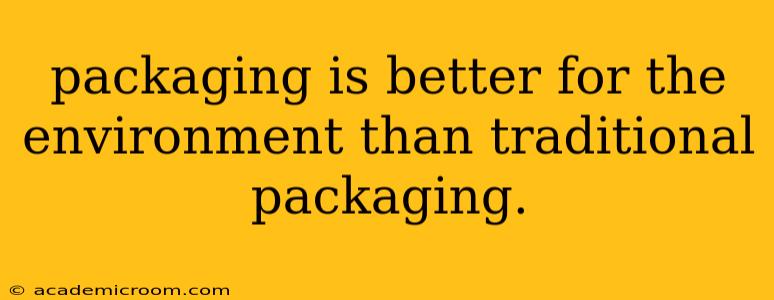The packaging industry is undergoing a significant transformation, driven by growing consumer awareness of environmental issues and stricter regulations. More and more, we're seeing a shift towards sustainable packaging options, but is it truly better for the environment than traditional packaging? The answer, as with most things, is nuanced. It's not a simple yes or no, and depends heavily on several factors. This article will delve into the complexities, exploring the pros and cons of both traditional and sustainable packaging to help you make informed choices.
What is Considered "Traditional" Packaging?
Before we dive into comparisons, let's define our terms. "Traditional" packaging generally refers to materials like:
- Plastics: Polyethylene (PE), Polypropylene (PP), Polyvinyl Chloride (PVC), and others. These are often inexpensive, durable, and versatile, but their non-biodegradability is a major environmental concern.
- Styrofoam (Expanded Polystyrene): Lightweight and shock-absorbing, Styrofoam is widely used but notoriously difficult to recycle and contributes significantly to landfill waste.
- Unbleached Paper and Cardboard: While biodegradable, the production of these materials often involves significant energy consumption and deforestation.
What are Sustainable Packaging Alternatives?
Sustainable packaging encompasses a broad range of materials and practices designed to minimize environmental impact. These include:
- Bioplastics: Made from renewable resources like corn starch or sugarcane, these offer a more sustainable alternative to petroleum-based plastics, but their compostability can vary greatly.
- Paper and Cardboard from Recycled Sources: Using recycled paper reduces the need for virgin fibers, conserving forests and lowering energy consumption.
- Compostable Packaging: This includes materials that break down naturally, returning to the earth without leaving harmful residues. Examples include materials made from seaweed, mushroom packaging, and certain types of bioplastics.
- Reusable Packaging: This encompasses containers designed for multiple uses, minimizing waste and resource consumption.
How Does Sustainable Packaging Compare in Terms of Environmental Impact?
The environmental impact depends on numerous factors, including:
- Material Sourcing: Sustainable packaging often relies on renewable resources, reducing our dependence on finite fossil fuels. However, the farming of raw materials for bioplastics can have its own environmental impact, such as water and land usage.
- Manufacturing Process: The energy and resources used in manufacturing significantly influence the overall carbon footprint. Sustainable packaging often aims to reduce energy consumption and emissions throughout the manufacturing process.
- Transportation: The distance materials travel to reach the manufacturer and consumer adds to their carbon footprint. Sourcing locally produced sustainable packaging helps to mitigate this impact.
- Waste Management: Biodegradable and compostable packaging reduces landfill waste. However, appropriate composting infrastructure is crucial for these materials to truly achieve their environmental benefits. Recycling rates for many sustainable packaging materials are also still improving.
- Product Protection: Sustainable packaging needs to effectively protect products during transportation and storage, balancing environmental concerns with product safety and shelf life.
What are the Different Types of Sustainable Packaging Materials?
Bioplastics: Are bioplastics always better?
Bioplastics are derived from renewable biomass sources, making them seem environmentally friendly. However, not all bioplastics are created equal. Some are compostable only in industrial composting facilities, while others require specific conditions for decomposition. Others still are only partially biodegradable and may pose a risk of microplastic pollution. Therefore, proper labeling and awareness about bioplastic types are crucial.
Paper and Cardboard from Recycled Sources: How does recycled packaging compare?
Recycled paper and cardboard reduce the demand for virgin fibers, minimizing deforestation and energy consumption. However, the recycling process itself consumes energy, and the quality of recycled material might slightly lower the packaging's strength.
Compostable Packaging: What's the best way to compost packaging?
Compostable packaging offers the potential for complete decomposition, returning nutrients to the soil. However, its effective composting requires the right conditions – usually industrial composting facilities – and not all compostable materials decompose at the same rate. Home composting may not always be suitable.
Is Sustainable Packaging More Expensive?
Generally, yes, sustainable packaging options often come with a higher price tag than traditional alternatives. This is due to factors like higher raw material costs, specialized manufacturing processes, and potentially less efficient supply chains.
What are the Challenges of Widespread Adoption of Sustainable Packaging?
Despite the environmental benefits, several challenges hinder the widespread adoption of sustainable packaging:
- Higher Costs: The economic viability of sustainable alternatives can be a significant barrier, especially for smaller businesses.
- Infrastructure Limitations: The lack of widespread composting infrastructure limits the effectiveness of compostable packaging. Similarly, robust recycling programs are needed for other sustainable options to succeed.
- Performance Differences: Sustainable materials may not always offer the same level of protection, durability, and shelf life as their traditional counterparts.
- Consumer Perception and Behavior: Educating consumers about the benefits of sustainable packaging and promoting proper waste management practices is essential for the success of these initiatives.
Conclusion: The Ongoing Evolution of Packaging
The shift towards sustainable packaging represents a crucial step towards a more environmentally responsible future. While sustainable options are not a perfect solution, they represent a significant improvement over traditional materials in many instances. The ongoing development of innovative materials, improved recycling infrastructure, and heightened consumer awareness will continue to shape the future of packaging, ensuring that it becomes increasingly environmentally friendly without compromising product safety and functionality.
